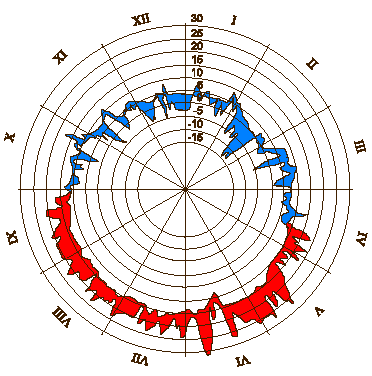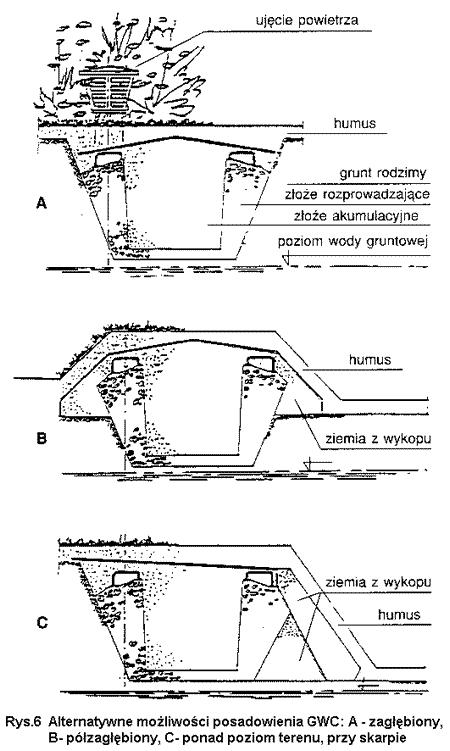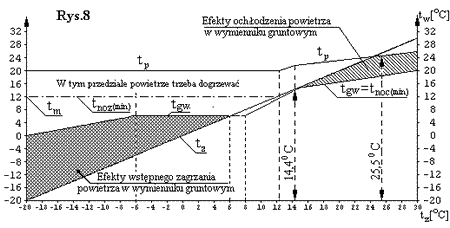| Characteristics of the
GHE - supplementary data to our offer |
- In the buildings where air
parameters have to be strictly observed (for instance in medical
services) ground heat exchangers can assist heating and cooling
systems (e.g. to cool down condensers in a conventional air
condition installation). Even fastidious investors would be
satisfied, as they can set up the parameters of their choice by
using supplementary devices.
- In the buildings where air
parameters have to be strictly observed (for instance in medical
services) ground heat exchangers can assist heating and cooling
systems (e.g. to cool down condensers in a conventional air
condition installation). Even fastidious investors would be
satisfied, as they can set up the parameters of their choice by
using supplementary devices.
- The parameters of air, leaving the
bed, are characterized be very slow changes in time,noticeable only
within a period of several months. These changes are almost
impossible to be noticed within a single month. This is an
advantage, because the impact of all abrupt changes of ambient
temperatures, both daily changes as well as periodical cooling or
warming, is reduced.
- During rapid warming in winter and
in transitional periods, as well as in case of abrupt cooling in
summer, the heat exchangers react with some delay. It can happen
then, that the parameters of the outgoing air, being used for
ventilating purposes, can be worse than the parameters of ambient
air. To prevent from such a situation, properly working automatic
control (fig. 5) should assure the air is taken from the most
favourable source.
- In autumn and late summer the
temperature of the outgoing air is higher than in winter or spring.
In the end of August/beg. of September it can reach 220C,
with the ambient temperatures approaching 320C. In the
end of February/beg. of March, whith ambient temperature falling
down to -200C, the temperatures of the outgoing air can
reach -20C, especially during the long and heavy „attack”
of frost in January and February. A high inertia of the exchanger
can result in shifting „climatic quarters” of the gravel bed
temperatures of ca. 2 months in relation to the seasons of the year.
The energetical profits throughout the
year. The differences in air temperatures at the GHE inlet and outlet:
styczeñ - January, luty - February, marzec - March,
kwiecien - April, maj - May, czerwiec - June,
lipiec - July, sierpien - August, wrzesien - September,
pazdziernik - October, listopad - November, grudzien -
December
|
| |

|
LOCATION AND
REQUIREMENTS: A GHE of a low output can be installed in the
foundations wall chambers or under a building, e.g. a garage. It can
also be located in the ground beside a building, being covered by a
lawn, car park for passenger cars, playground, etc. It can consist of a
single chamber (fig. 7) or several chambers (fig. 1).
|
| Fig 5. An example
scheme of a ventilating installation for a larger building: |

|
Fig. 5
translation of texts from the drawings:
powietrze zuzyte np. do rekuperatora - used air, e.g. for the
recuperator
klimatyzowany obiekt lub pomieszczenie - air conditioned building or
room
powietrze zewnetrzne, recyrkul., lub rekuper. - ambient air,
recirculation or recuperator
used air, e.g. for the recuperator air conditioned building or room
ambient air, recirculation or recuperation. Ground Heat Exchanger
12. Throttler
13. Air filter
14. Heater
15. Intake fan
16. Silencer
17. Air inlet
19. Exhaust fan
A inlet of the ambient
air humus native ground distributing bed accumulative bed ground water
level
B humus the soil from the excavation
C the soil from the excavation humus
|
 |
| Fig. 6
Various ways to locate the GHE: A-totally embedded; B-partly embedded;
C: exposed, at a slope
Fig. 6 In places
with superficial ground water a GHE can be located in the following
configurations:
a) entire GHE under the ground surface, with only an air suction
above
b) partly in-earth GHE, its part located in soil and the rest
above the ground level.
c) GHE at a slope, its two sides formed by the slope.
d) (no sketch) The GHE bottom on the ground surface. Thanks to an
insulation, going partly several centimeters in the soil, and partly on
the slope surface, the isothermes of the ground are brought up to the
exchanger, located over the ground surface (Normally to achieve similar
thermal effect, you have to increase the GHE volume). The resulting
height differences of the ground level can be used to design e.g. a
playground.
Fig. 6 translation of texts from the drawings:
ujecie powietrza - inlet of the ambient air
humus - humus
grunt rodzimy - native ground
zloze rozprowadzajace - distributing bed
zloze akumulacyjne - accumulative bed
poziom wody gruntowej - ground water level
ziemia z wykopu - the soil from the excavation
|
|
The costs of the GHE, constructed as
per fig. 6; prices acc. to KNR*. Fan wattage
assumed for a ground resistance GHE of 120Pa. |
| air flow rate
m3/h |
3000 |
6000 |
9000 |
15000 |
25000 |
110000 |
| exchanger type |
A |
B |
A |
B |
A |
B |
A |
B |
A |
B |
A |
| fan
engine.[kW] |
0,7 |
1,1 |
2,2 |
4,0 |
8,0 |
- |
|
net costs of GHE execution (1
€=+/- 4PLN) |
| Price[PLN] |
9537 |
8326 |
18358 |
16703 |
26668 |
24552 |
45882 |
40021 |
86556 |
75888 |
382420 |
Assumptions to the calculation: man-hour = 7,50 PLN,
indirect costs = 55%, costs of purchase= 12%, profit = 17%
* KNR = Material Cost Catalogue, an offical
publication, containing costs of materials |
|

|
Fig. 7
1. inlet of the ambient air,
2. horizontal air distributing duct, 3. the gravel bed,
distributing air to the GHE bottom, 4. gravel accumulating bed,
5. air collecting bed, 6. horizontal collecting duct,
6a. air intake to the building, 7. humus-soil, lawn, 8.foamed
polystyrene, thickness 100mm, both sides protected by foil, 9.native
soil,10. washing installation, 11. draining tube
with collecting well - for draining and control in case of a high
level of ground water. |
Examples of using
GHE in ventilating installations:
Cinema, theatre, etc. An exemplary
characteristics of the ventilating installation, acting simultaneously
with GHE in cinemas, theatres etc. Thanks to air cooling in the GHE, it
is possible to reduce an air flow rate pro person down to 20m3/h
(30% lower demand for fansand ventilating installations than in case of
traditional ventilation without cooling).
A lower air flow rate and preliminary
heating of ventilating air in the GHE in winter will result in a 60%
decrease of power consumption by the heaters. The air from a GHE can
beadditionally heated by a recuperator or mixed with the air leaving a
cinema hall (only in theseparts of the building where the used air is
free from scents). In such places (cinemas, theatres with a high number
of spectators) there is no need for any additional heat source, even
with the lowest ambient temperatures. This is made possible by using an
automatic adjustment system, in which the temperature of air mixture is
being adjusted to the room temperature by means of the throttles (12,
fig. 5) and a smooth regulation of the rotations of fan driving engines
(fans: 15, 19 in fig. 5).
|
 |
Fig. 8
translation of texts from the drawings:
Efekty ochlodzenia powietrza w wymienniku gruntowym - the
effect of air cooling in the ground heat exchanger
W tym przedziale powietrze trzeba dogrzewac - air has to be
heated within this range
Efekty wstepnego zagrzania powietrza w wymienniku gruntowym -
the effects of air preheating in the ground heat exchanger
Fig. 8 An example characteristics
of a ventilating installation, acting simultaneously with a GHE in
cinemas, theatres, concert halls, etc.
designations:
tp -
temp. in the building
tm -
temp. of the mixture or temp. of air after
recuperator (70% efficiency)
tz - tw
- outdoor and indoor
temp.
tgw -
temp. at the GHE outlet
tnoz tnoc
- air intake temp.
|
| |
Last change 20.03.2011
CHEAP AIRCON dition and heating ©
|





